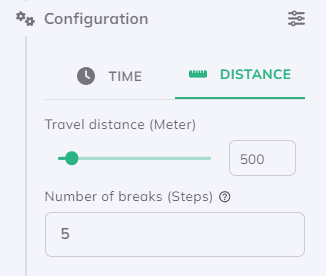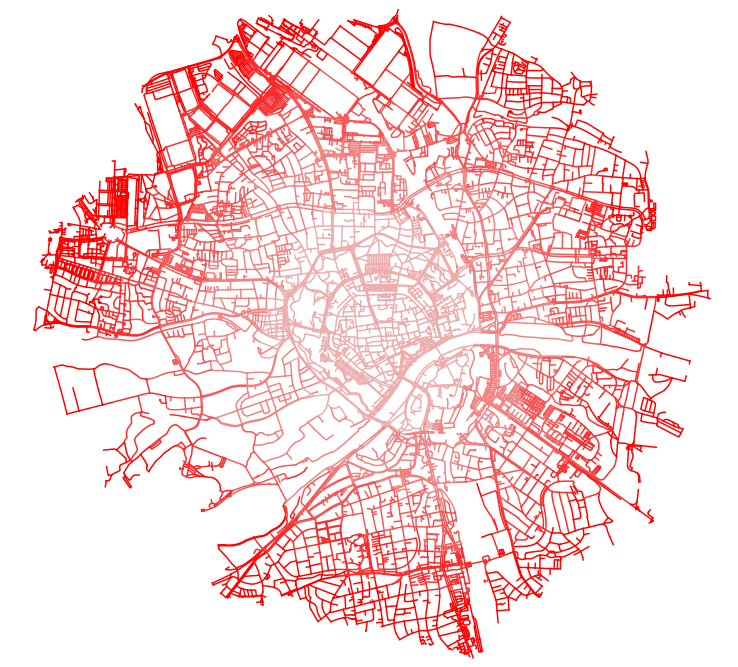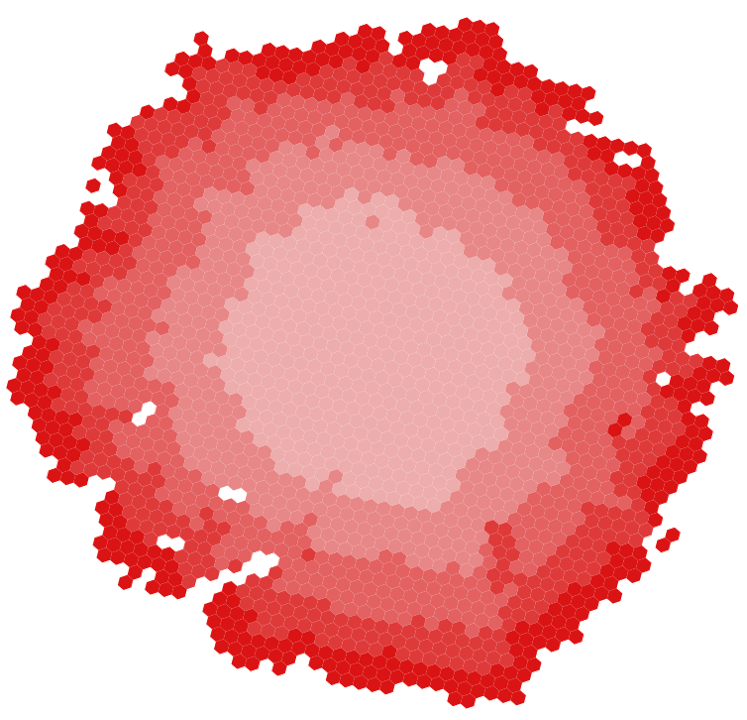Catchment Area
Catchment Areas show how far people can travel within a certain travel time or distance, using one or more modes of transport.
1. Explanation
Based on the specified starting point(s), maximum travel time or distance, and mode(s) of transport, Catchment Areas visualize the extent of accessibility. This is calculated using real-world data and provides useful insights into the quality, density, and extensiveness of an area's transport network.
Furthermore, the catchment area can be intersected with spatial datasets, such as population and POI data. This allows you to assess - for example - how many POIs can be reached from a certain location and therefore identify what share of inhabitants has access to important amenities within a specific travel time.

You might know this feature from our previous software versions under the terms Single-Isochrone and Multi-Isochrone. With the release of GOAT version 2.0, we combined these two indicators in the same flow and enriched it with further calculation options.
The computation of Catchment Areas is possible in specific regions.
Upon selecting a Routing type, GOAT will display a map overlay indicating this.
For Walk, Bicycle, Pedelec, and Car, over 30 European countries are supported, while Public Transport Catchment Areas may be computed for Germany.
If you need to perform analyses beyond these regions, feel free to contact us and we would be happy to discuss further options.
2. Example use cases
- Which amenities can be reached from a certain point in a 15-minute walk?
- How many inhabitants have access to a supermarket within 10 minutes of cycling?
- What share of the population has a general practitioner (GP) within 500m distance?
- How big is the catchment area of a workplace by car vs. by public transport? How many employees live within these catchment areas?
- How well are kindergartens currently distributed across the city? In which districts are there accessibility deficits?
3. How to use the indicator?
Toolbox Accessibility Indicators menu, click on Catchment Area.Routing
Routing Type you would like to calculate a catchment area.Configuration
- Walk
- Bicycle/Pedelec
- Car
- Public Transport (PT)
Walk
Considers all paths accessible by foot.
For further insights into the Routing algorithm, visit Routing/Walk.
- Time
- Distance
Time
Travel time limit, Travel speed, and Number of breaks.
For defining which travel time limits are suitable for which amenity, the "Standort-Werkzeug" of the City of Chemnitz can provide helpful guidance.
Advanced Configurations
Per default, the catchment areas are calculated in polygon shape. In case you want to adjust that, you find further options in the advanced configurations.
Catchment area shape. You can choose between Polygon, Network and Rectangular Grid.Distance
Travel distance and Number of breaks.
For defining which travel distances are suitable for which amenity, the "Standort-Werkzeug" of the City of Chemnitz can provide helpful guidance.
Advanced Configurations
Per default, the catchment areas are calculated in polygon shape. In case you want to adjust that, you find further options in the advanced configurations.
Catchment area shape. You can choose between Polygon, Network and Rectangular Grid.Bicycle/Pedelec
Considers all paths accessible by bicycle. This routing mode takes into account the surface, smoothness, and slope of streets while computing accessibility. For Pedelec, slopes are considered with a lower impedance than for standard bicycles.
For further insights into the Routing algorithm, visit Routing/Bicycle. In addition, you can check this Publication.
- Time
- Distance
Time
Travel time limit, Travel speed, and Number of breaks.
For defining which travel time limits are suitable for which amenity, the "Standort-Werkzeug" of the City of Chemnitz can provide helpful guidance.
Advanced Configurations
Per default, the catchment areas are calculated in polygon shape. In case you want to adjust that, you find further options in the advanced configurations.
Catchment area shape. You can choose between Polygon, Network and Rectangular Grid.Distance
Travel distance and Number of breaks.
For defining which travel distances are suitable for which amenity, the "Standort-Werkzeug" of the City of Chemnitz can provide helpful guidance.
Advanced Configurations
Per default, the catchment areas are calculated in polygon shape. In case you want to adjust that, you find further options in the advanced configurations.
Catchment area shape. You can choose between Polygon, Network and Rectangular Grid.Car
Considers all paths accessible by car. This routing mode takes into account speed limits and one-way access restrictions while computing accessibility.
For further insights into the Routing algorithm, visit Routing/Car.
- Time
- Distance
Time
Travel time limit and Number of breaks.
Advanced Configurations
Per default, the catchment areas are calculated in polygon shape. In case you want to adjust that, you find further options in the advanced configurations.
Catchment area shape. You can choose between Polygon, Network and Rectangular Grid.Distance
Travel distance and Number of breaks.
Advanced Configurations
Per default, the catchment areas are calculated in polygon shape. In case you want to adjust that, you find further options in the advanced configurations.
Catchment area shape. You can choose between Polygon, Network and Rectangular Grid.Public Transport (PT)
Considers all locations accessible by public transport. This routing mode considers inter-modal transfers including access to and from stations.
For further insights into the Routing algorithm, visit Routing/Public Transport.
Public transport modes you want to analyze (Bus, Tram, Rail, Subway, Ferry, Cable Car, Gondola and/or Funicular).
Travel time limit - the maximum allowed duration of journeys considered for the analysisNumber of breaks - determines the resolution of the resulting catchment area isochroneDay - the weekday type on which the analysis is performed: Weekday, Saturday or SundayStart Time and End Time - the fastest possible journeys within this time window are considered for the analysisRead more about routing options here.

The "Standort-Werkzeug" of the City of Chemnitz can provide helpful guidance on suitable travel time limits for assessing accessibility to various amenities.
Advanced Configurations
Per default, the catchment areas are calculated in polygon shape. In case you want to adjust that, you find further options in the advanced configurations.
Catchment area shape. You can choose between Polygon, Network and Rectangular Grid.- Polygon
- Network
- Rectangular Grid
Polygon
- It is the geometric representation of the catchments.
- Provides an easy-to-understand visualization of the catchment area.
- One polygon is produced for each
step.

If you enable Polygon Difference, only the "incremental" (or differential) polygon will be created for each step, but if you disable Polygon Difference, a "full" polygon will be created for each step (including the areas covered by all previous steps).
Network
- It is a street-level representation of the catchments.
- Enables easy correlation to actual streets and their accessibility within the catchment area.
- Fine-grained detail compared to the other catchment types.

Rectangular Grid
- It is a grid cell-based representation of the catchments.
- Appears similar to a “heatmap” visualization, however, differs conceptually & computationally (this represents egress from a specified origin to various other locations while heatmaps represent access from various locations to a specified destination).

Starting Points
Starting point method to define how you like to define the starting point(s) for the catchment areas. You can either Select on map or Select from layer.- Select on Map
- Select From Layer
Run. This starts the calculation of the catchment areas from the selected starting point(s).Depending on the chosen settings, the calculation might take some minutes. The status bar shows the current progress.
Results

Want to style your catchment areas and create nice looking maps? See Styling.
4. Technical details
Catchment areas are isolines connecting all points that can be reached from one or more starting points within a certain time interval (called isochrones) or distance (called isodistance). Depending on the chosen travel mode, the according transport networks are used for the routing.
The catchment areas are dynamically created in the front end based on a travel time/distance grid. Therefore, catchment areas can be created fast and for different intervals on the fly.
Scientific background
From the scientific background, catchments are contour-based measures (also known as cumulative opportunities). They are valued for their easily interpretable results (Geurs and van Eck 2001; Albacete 2016), but have the drawback of not distinguishing between different travel times within the cut-off range (Bertolini, le Clercq, and Kapoen 2005), as it is done by heatmaps.
Visualization
The catchment shape is derived from the routing grid using the Marching square contour line algorithm, a computer graphics algorithm that can generate two-dimensional contour lines from a rectangular array of values (de Queiroz Neto et al. 2016). This algorithm transforms the grid from a 2D array to a shape to visualize or analyze. An illustration of 2D image processing is shown in the figure.

5. Further readings
Further insights into the catchment calculation and its scientific background can be found in this publication.
6. References
Albacete, Xavier. 2016. “Evaluation and Improvements of Contour-Based Accessibility Measures.” url: https://dspace.uef.fi/bitstream/handle/123456789/16857/urn_isbn_978-952-61-2103-1.pdf?sequence=1&isAllowed=y
Bertolini, Luca, F. le Clercq, and L. Kapoen. 2005. “Sustainable Accessibility: A Conceptual Framework to Integrate Transport and Land Use Plan-Making. Two Test-Applications in the Netherlands and a Reflection on the Way Forward.” Transport Policy 12 (3): 207–20. https://doi.org/10.1016/j.tranpol.2005.01.006.
J. F. de Queiroz Neto, E. M. d. Santos, and C. A. Vidal. “MSKDE - Using Marching Squares to Quickly Make High Quality Crime Hotspot Maps”. en. In: 2016 29th SIBGRAPI Conference on Graphics, Patterns and Images (SIBGRAPI). Sao Paulo, Brazil: IEEE, Oct. 2016, pp. 305–312. isbn: 978-1-5090-3568-7. doi: 10.1109/SIBGRAPI.2016.049. url: https://ieeexplore.ieee.org/document/7813048
https://fr.wikipedia.org/wiki/Marching_squares#/media/Fichier:Marching_Squares_Isoline.svg
Majk Shkurti, "Spatio-temporal public transport accessibility analysis and benchmarking in an interactive WebGIS", Sep 2022. url: https://www.researchgate.net/publication/365790691_Spatio-temporal_public_transport_accessibility_analysis_and_benchmarking_in_an_interactive_WebGIS
Matthew Wigginton Conway, Andrew Byrd, Marco Van Der Linden. "Evidence-Based Transit and Land Use Sketch Planning Using Interactive Accessibility Methods on Combined Schedule and Headway-Based Networks", 2017. url: https://journals.sagepub.com/doi/10.3141/2653-06
Geurs, Karst T., and Ritsema van Eck. 2001. “Accessibility Measures: Review and Applications.” RIVM Report 408505 006. url: https://rivm.openrepository.com/handle/10029/259808